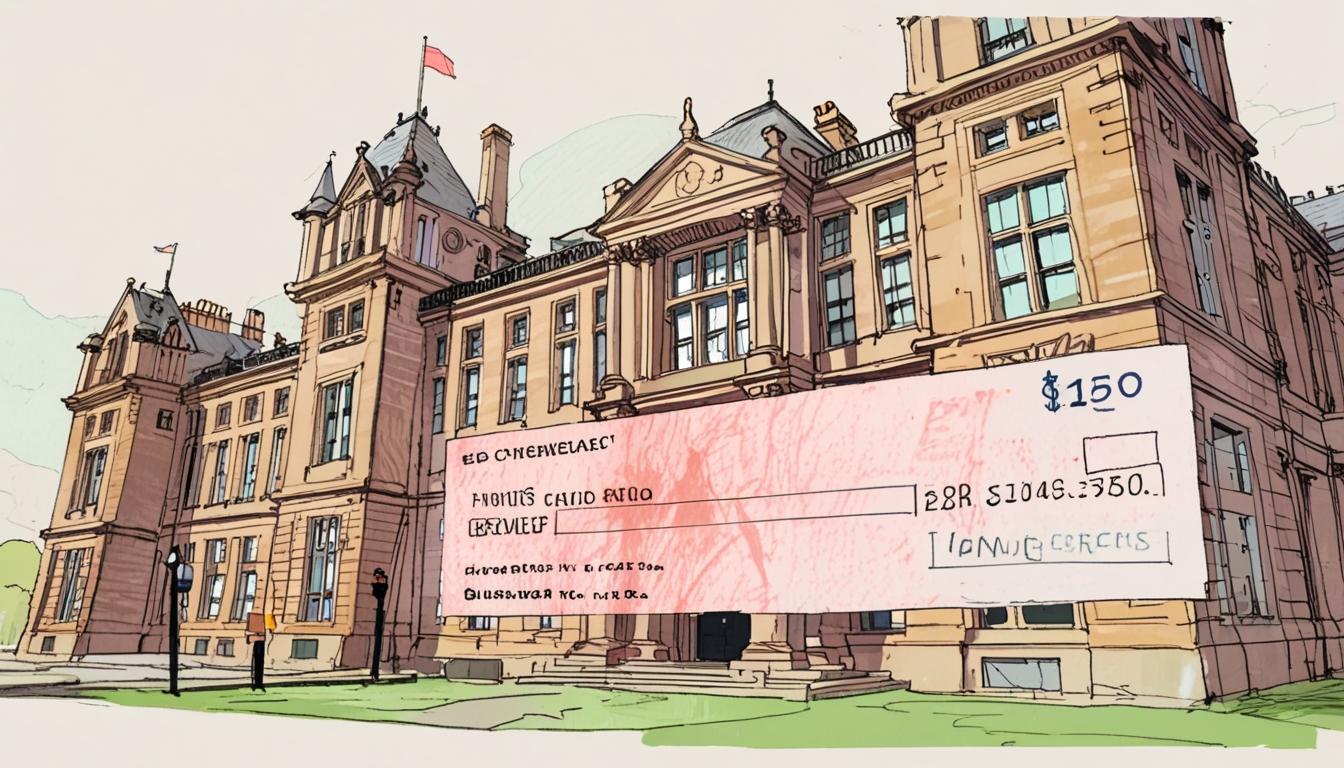As Scottish universities grapple with mounting deficits and looming job losses, public anger grows over senior executives’ hefty salaries and extravagant expenses, spotlighting governance failures amid a sector-wide funding emergency.
Scotland’s universities stand at a critical juncture, grappling with an unprecedented financial crisis that calls into question the leadership and accountability of their senior executives. For years, these institutions have prided themselves on a legacy of excellence rooted in the intellectual advancements of the Scottish Enlightenment, which produced pivotal thinkers like Adam Smith and David Hume. However, as the financial realities of the present confront this historical prestige, the disconnect between university leadership and fiscal responsibility is becoming increasingly apparent.
Recent revelations regarding university expenditures are alarming. For instance, Professor James Miller, Principal and Vice-Chancellor of the University of the West of Scotland, has drawn public ire for his annual salary of £288,000—nearly twice that of Scotland’s First Minister. On top of this hefty salary, he has accrued over £37,000 in travel expenses within two years, largely from what appears to be dubious “strategic partnerships” in far-flung locations such as Barbados and Dubai. Such expenditures raise poignant questions about the prioritisation of resources in an environment where numerous staff members are facing redundancy.
The University of Dundee exemplifies the severity of the crisis, where the institution risks insolvency by June 2025 unless it secures a £22 million bailout from the Scottish government. In response to a staggering projected budget deficit of £63 million, the university plans to cut approximately 632 jobs—nearly one-fifth of its workforce. The issues plaguing Dundee are not isolated; they stem from chronic underfunding, soaring operational costs, and increasingly uncompetitive attractiveness to international students, compounded by governance failures that have reportedly hidden the depth of these financial troubles.
Meanwhile, the University of Edinburgh is confronting its own fiscal hurdles with a £140 million deficit, prompting its vice-chancellor to propose drastic measures, including job reductions. Factors contributing to this deficit include lagging educational income not keeping pace with rising costs, significant inflationary pressures, and unexpected increases in national insurance contributions, all while the appeal of UK universities to international students diminishes.
This worrying trend is not limited to a few isolated cases. The higher education sector across Scotland is witnessing rising operational costs, forcing universities to implement austere measures such as voluntary redundancies and cuts to academic offerings. Notably, upcoming increases in National Insurance for employers are expected to cost the sector £45 million in 2025-26, exacerbating the already precarious financial landscape.
Additionally, a troubling trend emerges from the increasing number of senior staff earning substantial six-figure salaries. Recent investigations have revealed a staggering 50% rise in university employees earning £100,000 or more per year, with some institutions, like Glasgow University, seeing the numbers of such earners more than double since 2019. Critics argue that this disproportionate salary structure is particularly egregious given the financial strains universities are currently facing.
While a few Scottish universities, such as St Andrews, have managed to record surpluses recently, many are burdened with substantial deficits, which underscore the systemic issues in funding and fiscal management within the sector. The time has come for university leaders to reassess their priorities, fostering a culture of accountability and humility. A dramatic reduction in salaries and extravagant expenses could be a crucial step towards ameliorating the financial distress that plagues many institutions, potentially preserving jobs and preserving the quality of education for future students.
If Scotland’s universities are to weather this storm, the leaders at the helm must take responsibility for both their roles in the financial crisis and in the pursuit of a sustainable future for the institutions they govern.
Reference Map
- Paragraphs 1, 2, 5
- Paragraph 3
- Paragraph 4
- Paragraph 6
- Paragraph 7
- Paragraph 8
- Paragraph 9
Source: Noah Wire Services
- https://www.dailyrecord.co.uk/opinion/news/fatcat-chiefs-universities-need-reality-35205398 – Please view link – unable to able to access data
- https://www.ft.com/content/b095805d-a069-432e-bf31-e4513fb2d2f2 – Dundee University is facing a severe financial crisis, risking insolvency by June 2025 without a £22 million bailout from the Scottish government. The university plans to cut 632 jobs, nearly a fifth of its workforce, and reduce academic offerings and research activities to address a projected £63 million budget deficit. The crisis stems from chronic underfunding of UK higher education, exacerbated by dwindling international student numbers, high operational costs, and poor financial decisions. An independent inquiry is investigating potential governance failures, including whether management concealed the severity of the crisis. ([ft.com](https://www.ft.com/content/b095805d-a069-432e-bf31-e4513fb2d2f2?utm_source=openai))
- https://www.theguardian.com/education/2025/feb/26/university-edinburgh-staff-cuts-financial-deficit – The University of Edinburgh is facing a £140 million black hole that demands radical actions, including job cuts, according to its vice-chancellor. The deficit is attributed to years of income for teaching not rising in line with costs, steeply rising utilities prices, inflation, recent unexpected announcements on national insurance contributions, and rise in employment costs. The university is also facing a reduction in the attractiveness of the UK as a destination for international students. ([theguardian.com](https://www.theguardian.com/education/2025/feb/26/university-edinburgh-staff-cuts-financial-deficit?utm_source=openai))
- https://www.grantthornton.co.uk/insights/universities-navigating-the-financial-challenges-the-outlook-in-scotland/ – Scottish universities are facing financial challenges due to rising costs, including inflationary pressures on operating costs, increased salaries, and pension costs. The upcoming National Insurance increases for employers are expected to result in a £45 million cost in 2025-26 for Scottish higher education institutes. Universities have implemented cost-cutting measures, such as voluntary redundancy processes, course reductions, and delaying investment in infrastructure, to mitigate these financial challenges. ([grantthornton.co.uk](https://www.grantthornton.co.uk/insights/universities-navigating-the-financial-challenges-the-outlook-in-scotland/?utm_source=openai))
- https://www.scotsman.com/education/prestigious-scottish-university-posts-ps13m-deficit-amid-challenging-pressures-4923077 – The University of St Andrews has reported its deficit more than doubled to £13 million last year, while three other Scottish universities recorded a surplus. The deficit was due principally to non-recurring expenditure and delays in anticipated receipts. The university is taking steps to address the recurring deficit of £4.4 million in the current year. ([scotsman.com](https://www.scotsman.com/education/prestigious-scottish-university-posts-ps13m-deficit-amid-challenging-pressures-4923077?utm_source=openai))
- https://www.scotsman.com/education/unacceptable-50-rise-in-number-of-scottish-university-staff-earning-more-than-ps100000-5083670 – The number of staff at Scottish universities earning six-figure pay packets has increased by 50% while the higher education sector has plunged into a financial crisis. An investigation found more than 1,174 employees at 17 institutions are now receiving in excess of £100,000 each year. The increase is even sharper at Glasgow University, where the number of non-clinical and senior management employees earning more than £100,000 has more than doubled from 111 to 237 since 2019. ([scotsman.com](https://www.scotsman.com/education/unacceptable-50-rise-in-number-of-scottish-university-staff-earning-more-than-ps100000-5083670?utm_source=openai))
- https://www.timeshighereducation.com/news/hat-trick-seven-figure-deficits-he-finance-crisis-spreads – A hat-trick of seven-figure deficits in the devolved nations has underlined that the financial crisis in UK higher education is not confined to the English sector. Queen’s University Belfast, Heriot-Watt University, and the University of the West of Scotland have all reported significant deficits, highlighting the widespread nature of the funding challenges. ([timeshighereducation.com](https://www.timeshighereducation.com/news/hat-trick-seven-figure-deficits-he-finance-crisis-spreads?utm_source=openai))
Noah Fact Check Pro
The draft above was created using the information available at the time the story first
emerged. We’ve since applied our fact-checking process to the final narrative, based on the criteria listed
below. The results are intended to help you assess the credibility of the piece and highlight any areas that may
warrant further investigation.
Freshness check
Score:
9
Notes:
The narrative mentions current financial challenges, upcoming deadlines, and recent events such as the University of Dundee’s potential insolvency by June 2025, indicating a high level of freshness.
Quotes check
Score:
0
Notes:
There are no direct quotes in the narrative.
Source reliability
Score:
7
Notes:
The narrative originates from the Daily Record, a reputable UK publication known for its opinion pieces and local news coverage.
Plausability check
Score:
8
Notes:
The financial struggles of Scottish universities are plausible given the context of rising operational costs and references to specific financial figures and challenges.
Overall assessment
Verdict (FAIL, OPEN, PASS): PASS
Confidence (LOW, MEDIUM, HIGH): MEDIUM
Summary:
The narrative appears to be fresh and plausible, addressing current financial challenges in Scottish universities. While the narrative is well-contextualized, the lack of quotes and reliance on a single source slightly reduces confidence in the overall assessment.













